Korean War "Devotion" , Battle of Chosin Reservoir, LT/JG Thomas Hudner and ENS Jessie Brown Medal of Honor Mission Dec. 4th, 1950
This is a build that I have wanted to do for many years now. It covers a story that some of you will recognize right away. Some of you may not. Please read along with me and I'll explain. Be warned, some of what I'm going to be telling you will be graphic in nature. I am also posting this article at the exact same time these events transpired, only 70 years later. Korea is in a different time zone from us here in the US. They are a day ahead of us, that's why I posted this on December 3rd, in place of the 4th.
This story has a very personal meaning to me, as my Dad was there, and he was one of the "Frozen Chosin" as the survivors of this epic battle called themselves.
What most people don't realize about this battle, is that the US Army was right there alongside the Marines fighting against the Chinese...The 31st Regimental Combat Team, serving as part of the 7th Infantry Division was there. You hardly ever hear of their sacrifices or how they helped to save the Marines in this horrible conflict. I'm not trying to downplay what the Marines did here, as what transpired over this two week nightmare showed numerous instances of bravery by the Marines AND the US Army.
Here's a link to what Wikipedia has to say about this.
https://en.wikipedia.org/wiki/Task_Force_Faith
My Dad, who was part of "Task Force Faith" as it later became known, finally started opening up to me about some of his wartime experiences in his last two weeks of his life. Prior to this, he would hardly ever talk about any of it, and when he did, he would only tell me bits and pieces of the many horrors that he personally experienced while serving in Korea. Dad told me that it was SO cold there at the Chosin reservoir area, that water froze solid in his canteen in a matter of only minutes. It was even a struggle just to have any drinking water. Some of the men ate ice, but this only helped to create more "cold weather injuries". Dad didn't shave, or bathe for a little over a month, and he had a full beard when he finally reached Hungnam. He also joked that President Truman still owed him a Turkey Dinner for Thanksgiving that year, as he never got to eat his.
It was too cold for weapons to fire properly, and vehicles froze and wouldn't start. Some tanks actually had their tracks freeze solid to the ground. So the "Tankers" would put wooden logs under the tracks to help keep this from happening, if they were going to be in an area for a little while. Part of the US Army's 31st Regimental Tank Company were assigned to the Marines, and they provided needed armor protection. They also had to start and run all vehicles periodically so they wouldn't freeze to the point they were no longer useful, or else they wouldn't run when they were needed.
Dad told me about how he saw some of his friends, who were wounded and being transported to an evacuation point in the back of trucks, get killed by the thousands of Chinese soldiers who overran their positions. He told me it was a suicide mission to be a driver in one of these medevac trucks, as the Chinese would set up road blocks on the long and treacherous route back to the port of Hungnam. Dad said they always tried to kill the truck drivers first. This would in turn stop the convoys.
Some of these evacuation trucks were set on fire while the wounded men inside were burned alive. Sometimes the Chinese soldiers would toss in a grenade first, at other times they would get up into the trucks and take personal belongings from these dying and wounded men, like their wedding or class rings, wallets, and wrist watches, then the Chinese would shoot the wounded men, killing them up close and personal at point blank range. Dad told me about how some of the wounded men would be bayonetted and killed first, before these trucks were then set on fire. Sometimes the Chinese would toss in a thermite grenade, or a white phosphorous grenade, instead of your typical fragmentation type. They used what they had available to them, and Dad told me the Chinese also had a good supply of captured American "Pineapple" grenades.
At other times the Chinese would set up actual physical barriers to stop the convoys from moving along the road. On occasion, the ice would cause a vehicle in the convoy to slide off the winding road, which was nothing more than a small dirt trail in some places. When this happened, the truck , jeep or whatever type of vehicle it was, would roll down the side of the mountain until it came to a stop at the bottom. As it would roll down the mountainside, it tossed the occupants out. Remember this was a time before seat belts ...Sometimes these victims would be crushed by the vehicle as it rolled over the top of them.
So in order to help prevent this from happening on a more wide scale, the men in my Dad's unit were tasked with clearing the tops of the mountains and "eliminating" any pockets of Chinese soldiers they encountered. The F4U-4 Corsairs, along with AD Skyraider's were often called in for close air support missions. At other times, tanks were used to fire directly at the Chinese troops if they could be seen and they had a direct line of fire.
Dad told me that the Corsair and Skyraider pilots were very good at dropping napalm, which was a jellied gasoline that ignited upon impact. They also used GP, "General Purpose" bombs, and rockets, to clear the hilltops. He told me these pilots could drop their ordnance with pinpoint accuracy. He also told how gruesome it was, and how bad it smelled when they found dead Chinese soldiers that had been killed by the Napalm strikes. Dad told me that burnt flesh has a smell you will never forget. I'm a retired firefighter, and I have also experienced that same smell. It stays with you, believe me...
He told me a lot more, but I'm not going into these horrendous details, for obvious reasons. I will tell you this: Freedom is NOT free. One good thing did happen on occasion. It was SO cold there, that some of the wounded wouldn't bleed as bad because they froze and this would stop the flow of blood. As they "thawed out" Dad told me these men would start bleeding again. He also mentioned how the medics would carry morphine ampules in their mouths so they could use them when they needed them for a wounded man. If they didn't do this, the morphine would freeze solid in minutes. Dad also praised the C-47 pilots... but that's another story.
This leads up to my dual 1/48 scale F4U-4 Corsair builds, and the story of Thomas Hudner, and his wingman Jesse Brown. This is what Wikipedia has to say about the day that LT /JG Hudner earned his Congressional Medal of Honor.
This next section is copied directly from Wiki.
"On 4 December 1950, Hudner was part of a six-aircraft flight supporting U.S. Marine Corps ground troops who were trapped by Chinese forces. At 13:38 hours, he took off from Leyte with squadron executive officer Lieutenant Commander Dick Cevoli, Lieutenant George Hudson, Lieutenant Junior Grade Bill Koenig, Ensign Ralph E. McQueen, and the first African American Naval Aviator, Ensign Jesse L. Brown, who was Hudner's wingman. The flight traveled 100 miles (160 km) from Task Force 77's location to the Chosin Reservoir, flying 35 to 40 minutes through very harsh wintery weather to the vicinity of the villages Yudam-ni and Hagaru-ri. The flight began searching for targets along the west side of the reservoir, lowering their altitude to 700 feet (210 m) in the process. The three-hour search and destroy mission was also an attempt to probe Chinese troop strength in the area.
Though the flight spotted no Chinese, at 14:40 hours, Koenig radioed to Brown that he appeared to be trailing fuel. The damage had likely come by small arms fire from Chinese infantry, who were known to hide in the snow and ambush passing aircraft by firing in unison. At least one bullet had ruptured a fuel line. Brown, losing fuel pressure and increasingly unable to control the aircraft, dropped his external fuel tanks and rockets and attempted to land the craft in a snow-covered clearing on the side of a mountain. Brown crashed into a bowl-shaped valley at approximately 40°36′N 127°06′E, near Somong-ni, 15 miles (24 km) behind Chinese lines, and in 15-degree weather.
The aircraft broke up violently upon impact and was destroyed. In the crash, Brown's leg was pinned beneath the fuselage of the Corsair, and he stripped off his helmet and gloves in an attempt to free himself, before waving to the other pilots, who were circling close overhead. Hudner and the other airborne pilots thought Brown had died in the crash, and they immediately began a mayday radio to any heavy transport aircraft in the area as they canvassed the mountain for any sign of nearby Chinese ground forces. They received a signal that a rescue helicopter would come as soon as possible, but Brown's aircraft was smoking and a fire had started near its internal fuel tanks.
Hudner attempted in vain to rescue Brown via radio instruction, before intentionally crash-landing his aircraft, running to Brown's side and attempting to wrestle him free from the wreck. With Brown's condition worsening by the minute, Hudner attempted to drown the aircraft fire in snow and pull Brown from the aircraft, all in vain. Brown began slipping in and out of consciousness, but in spite of being in great pain, did not complain to Hudner.
A rescue helicopter arrived around 15:00 hours, and Hudner and its pilot, Lieutenant Charles Ward, were unable to put out the engine fire with a fire extinguisher. They tried in vain to free Brown with an axe for 45 minutes. They briefly considered, at Brown's request, amputating his trapped leg. Brown lost consciousness for the last time shortly thereafter. His last known words, which he told Hudner, were "tell Daisy I love her."
The helicopter, which was unable to operate in the darkness, was forced to leave at nightfall with Hudner, leaving Brown behind. Brown is believed to have died shortly thereafter of his injuries and exposure to the extreme cold. No Chinese forces threatened the site, likely because of the heavy air presence of the VF-32 pilots.
LT/ JG Hudner begged superiors to allow him to return to the wreck to help extract Brown, but he was not allowed, as other officers feared an ambush of the vulnerable helicopters resulting in additional casualties. In order to prevent the body and the aircraft from falling into Chinese or North Korean hands, the U.S. Navy bombed the crash site with napalm two days later; the aircrew recited the Lord's Prayer over the radio as they watched flames consume Brown's body. The pilots observed that his body looked to have been disturbed and his clothes stolen, but he was still stuck in the aircraft. The remains of both Brown and the aircraft were never recovered. Brown was the first African American U.S. Navy officer killed in the war.
LT/ JG Thomas Hudner received the Medal of Honor from President Harry S. Truman on 13 April 1951.
The 4 December, 1950, incident grounded Hudner for a month, as he injured his back in the landing, an injury he later said persisted for 6 to 8 years. He flew 27 combat missions during the war, serving there until 20 January 1951, when Leyte was rotated back to the Atlantic Fleet. On 13 April 1951, Hudner received the Medal of Honor from President Harry S. Truman, meeting Brown's widow, Daisy Brown, in the process. The two stayed in regular contact for at least 50 years following this meeting.
He was the first service member to receive the medal during the Korean War, though several others would receive the medal for actions which occurred before 4 December 1950.
Hudner said he was occasionally criticized for his actions, and that "about 90" people had told him he acted recklessly. His commanders noted his actions may have endangered the helicopter pilot and sacrificed an aircraft, criticisms Hudner later said did not make him regret his decision, as he felt it was a spur-of-the-moment action. Still, commanders later issued orders forbidding pilots from crash-landing in a similar way to try to save downed wingmen. On later reflection, Hudner indicated he did not consider himself a hero for his actions.
My friend Gary Sausmikat, @gwskat
Has also built a pair of these Corsairs. He used Hasegawa kits for his builds, where I used a Hobby Boss version to replicate Hudner's plane, and a Hasegawa kit for Brown's. Without Gary's help, I wouldn't have been able to build these two planes. Gary not only provided some insight to these two Corsairs, but he also sent me in the right direction by providing me a source where I could purchase the decal set I needed for this build.
Thanks Gary ! You rock brother... 🙂
In Gary's article, he mentions the book called "Devotion", that was written by the acclaimed author Adam Makos.
Hudner's official biography—Devotion: An Epic Story of Heroism, Friendship, and Sacrifice—was released in October 2015, after seven years of collaboration with author Adam Makos.
Here in this next picture, you can see Adam along with Thomas Hudner, as they were attempting to negotiate with the North Koreans in an effort to repatriate the remains of Jesse Brown...
Sadly they were told to come back later in September "when the weather is better". Keep in mind this meeting took place in July of 2015.
Here's a link to Gary's builds in case you're interested.
I built these two Corsairs and posted a step by step build journal as part of our ever growing Korean War group build. I used a Hobby Boss F4U-4 "Late Version" model kit, as I was able to determine the Corsairs both had a flat windshield, using the Bureau Numbers for both planes.
I used a spare set of "left over" dropped flaps from a Tamiya F4U-1 kit on the Hobby Boss model, which is #205 as flown by Thomas Hudner. I also offset the rudder, and close off the open area on the fuselage located under the rudder using plastic sheeting.
I used some "Ultra Bright Chrome" colored bare metal foil on the shock absorber portion of the main landing gear oleo struts. The rockets were leftovers from several 1/48 scale Hasegawa F6F "Hellcats".
The Hasegawa kit was used for Jesse Brown's Corsair, and it was built straight from the box. It is still a nice looking F4U in my opinion, even though the kits is rather old now.
On Jesse Brown's Corsair, I chose to use the nose number "203" because it is not known with 100 percent certainty of the nose number. The decal sheet I used included a spare number "217" which "could have" been the nose number for Jesse's Corsair.
The Hasegawa Corsair builds up very fast, but the cockpit is a little bare. It doesn't hurt things, because I painted the interior using a mixture of "Flat Black" and "Interior Green" for the various parts inside. Not much can be seen, so it's no big deal for me.
I used some stretched clear sprue plastic from the canopy parts trees to make the antennae cables. Overall these two planes were very fun to build, and I enjoyed the building experience a whole lot. I would pick the Hobby Boss Corsair as the better kit as it has much better details, especially the engine, cockpit and landing gear wells, including the tail wheel section of the fuselage.
Here you can see the two sitting directly across from each other. I'm very happy with the results of this build, and I can check one more thing off my "bucket list".
On the Hobby Boss kit, I offset the elevator trim tabs to mimic what I have seen on a full sized Corsair that I had the opportunity to see recently at the WW2 aircraft restoration shop where several friends of mine work... Here you can see how the smaller portion of the elevator trim tabs have been repositioned.
This mild trim tab modification is covered in the build journal, which can be seen by following this link.
Thank you for reading this. It's my way of recognizing and honoring these brave men, one of which was my Dad.
Freedom is NOT free... If you don't believe it, try taking a trip to your local VA hospitals and other military treatment centers. There you can see the effects of War first hand. We owe a lot to these men and women who keep us safe.
You can read more about Thomas Hudner by following this link at Wikipedia.
https://en.wikipedia.org/wiki/Thomas_J._Hudner_Jr.As always, comments are encouraged.
Stay safe.
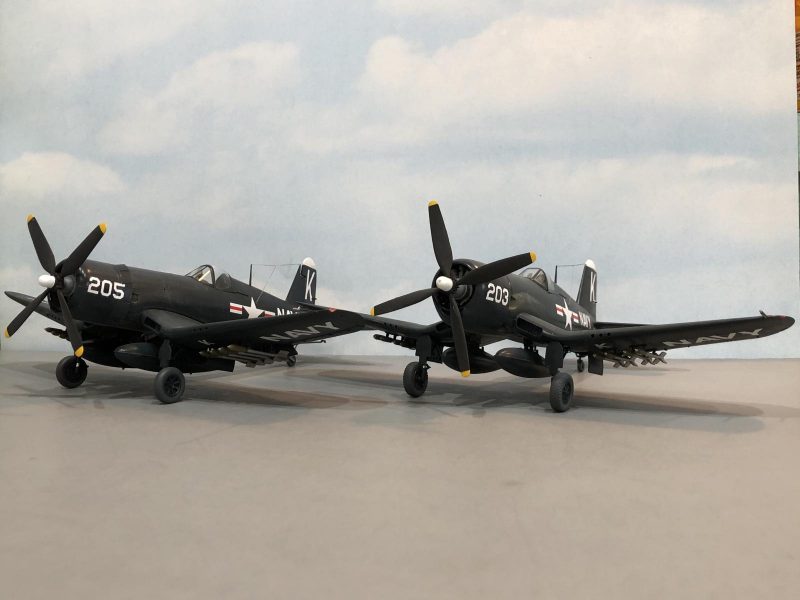


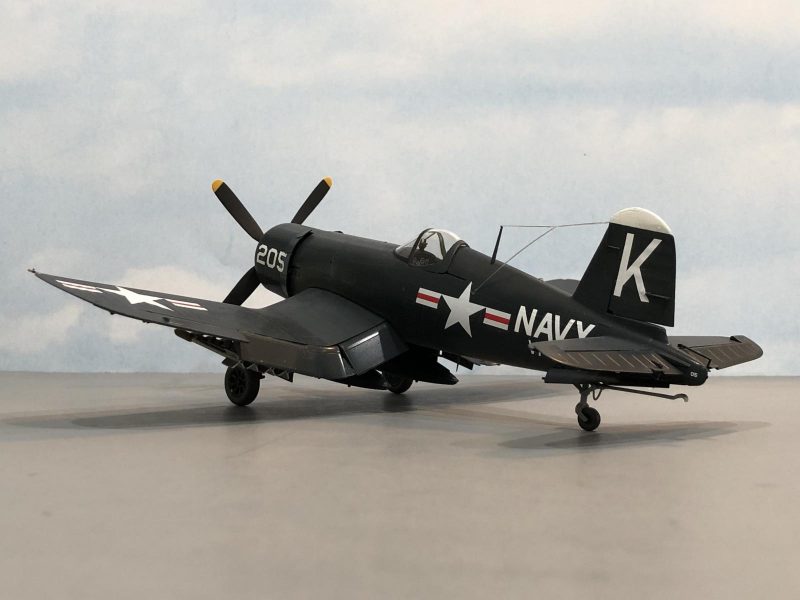

















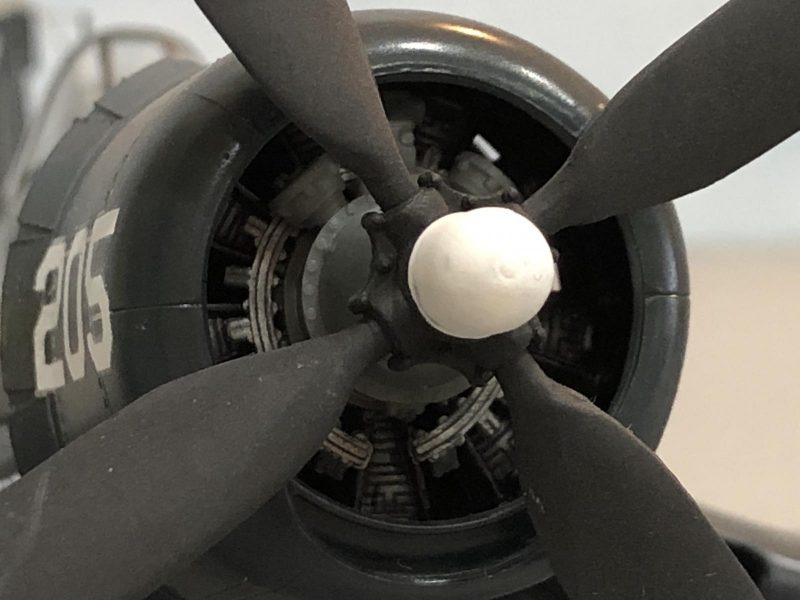

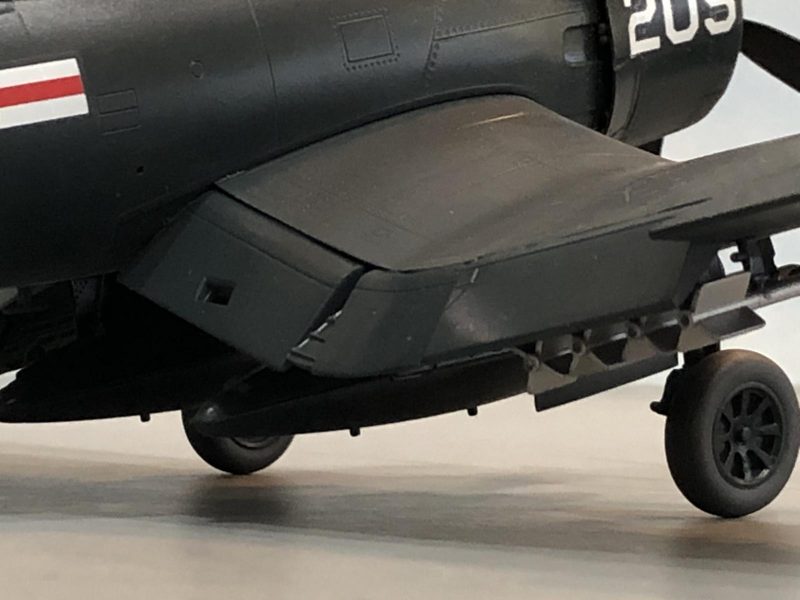




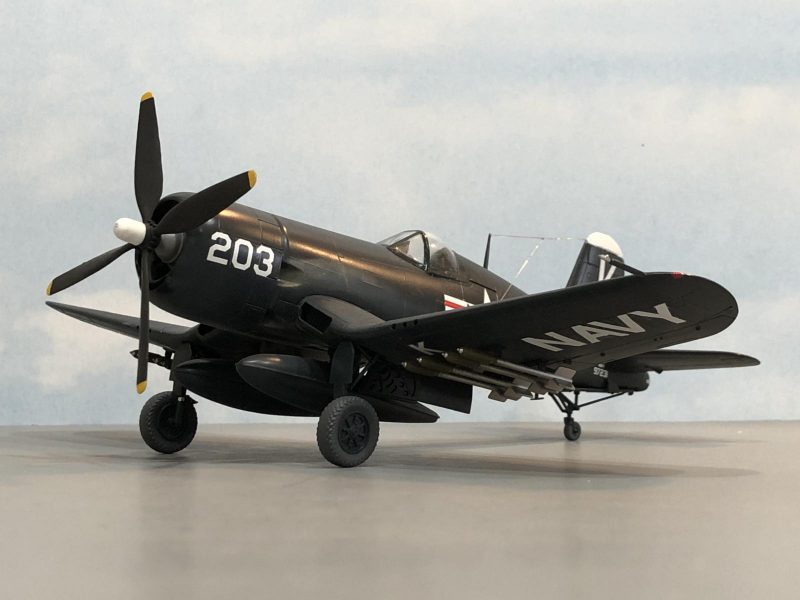
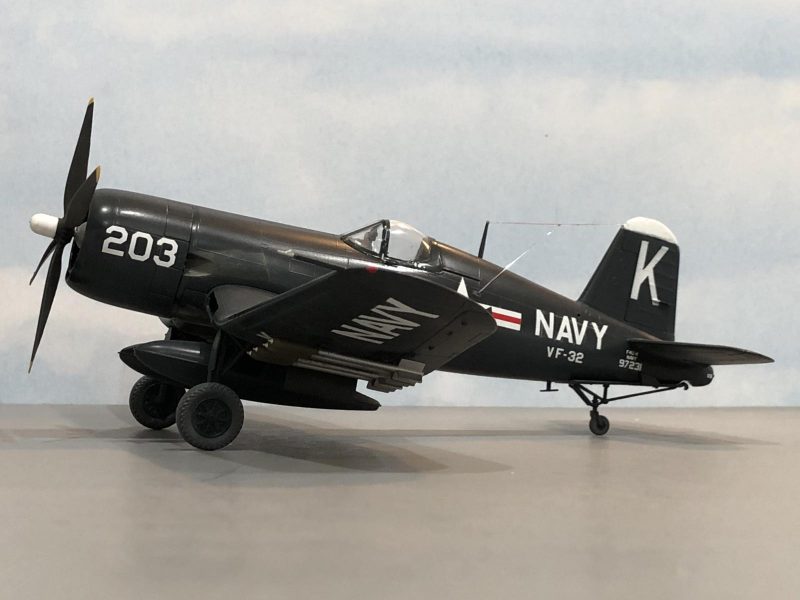













Lovely models and great posting Louis, well done.
Excellence all around - story, modelling, photography. Well done and educational, Louis. A fitting tribute to the men involved.
A moving story which I know means a lot to you, and this shows in the dedication needed for these builds. As you often say "I pressed the liked button".
Wow! Such a moving story and tribute. Thank you for sharing your father’s story. Those men fought bravely in a pure hell.
Outstanding overall build and story Louis. Not only passion for the build, but for the men who took part in this compelling story. Weaving in your personal take with your father's service in the US Army in Korea also adds an extra edge as well. The Corsairs are excellent and the men who flew them and died in them. Thanks for sharing this with us. God bless. Fly Navy
Chuck
What an impressive part of history, Louis.
Thanks for sharing this story with us.
Those great looking builds are a nice tribute to all involved.
Great work on the models and great work on the story, Louis. Having written a book on this event, I wish I had known you back in 2015 and that your dad had been around then and willing to talk, to get his story. You've told about 1/10 of what happened to Task Force Faith, named for its commander, LCOL Don Faith. For many years after, Task Force Faith was historically portrayed as a "hard luck" group with poor leadership who accomplished nothing. But further study has revealed that the sacrifice of the unit was what allowed the Marines at Yudam-ni to hold on and stabilize so they could retreat back to Hagru-ri. Your father and his fellow soldiers were a regimental combat team fighting what is now known to have been eight Chinese divisions; had those units been able to attack the Marines, history would tell the story of The Surrender at Chosin rather than the Retreat From Chosin. Task Force Faith is now seen as perhaps the crucial unit, that their sacrifice saved the rest.
Here's a couple little "color additions."
Hudner told me that when he turned final to crash land and dropped his flaps, he thought to himself, "This is really stupid..."
There were a total of 14 Medals of Honor awarded for the Chosin campaign and 85 Navy Crosses, the majority of which were awarded in lieu of an original nomination for the MOH. In addition to the "combat" MOH awards, 16 Navy corpsmen with the Marines were so honored, 14 of them posthumously. That tells you just how bad things were.
The Marines and Army survivors were the only US unit to come out of North Korea as an organized force. Secretary of State Dean Acheson called the Chinese Intervention in Korea "the worst defeat of American arms since the Second Battle of Bull Run." In his history of the war, British historian Sir Martin Gilbert called it "the most thorough defeat of a previously-victorious force in recorded history." The Marine withdrawal has been compared with the tale of Xenophon and the 10,000 Greeks who got out of Persia in 406 BC, , told in "The Anabasis."
The People's Volunteer Army was 200,000 strong, half on either side of the peninsula. They carried everything on their backs, marching at night and staying under cover in the forests by day; US reconnaissance was looking for a "Western" Army and couldn't find them. The one thing was that they were the Ninth Route Army of the People's Liberation Army and came from Canton province in the south. Most had never seen snow before, and they were less equipped to face the winter than the US forces were. Best estimates are that 40,000 of them froze to death after being wounded since they had no medical treatment like the UN forces did.
Most of that had to do with what happened to the Eighth Army on the western side of the peninsula. "The Big Bug-out" as it was known was the longest retreat in US Army history, 119 miles. the big problem was that even after they were hit with overwhelming force, MacArthur refused to believe the reports he received and would not give permission for the units to fall back in good order before they were surrounded and forced to retreat in what turned into a rout. Second Infantry Division, retreating from the Chongchon River to Kunu-ri, was caught with most of its vehicles in a 5-mile long pass, forced to stick to a "road" that was really an oxcart path, with the hills to either side filled with enemy troops. Over the two days it took to get out, the division suffered 3,500 dead. It took six months to restore the unit to combat capable, just in time to participate in the final mobile battles of the war at the Iron Triangle in May 1951. The event is known in the division history as "The Death Ride to Kunu-ri." The Chinese did to Second Division what you described them doing to Task Force Faith.
What saved Eighth Army in the end was the retreat turned into a rout and they literally outran their pursuers.
Interestingly, this year has seen China officially celebrating their victory in the Korean War. While officially "nobody won" the war, they have a pretty good argument. To them, they won because ever since the rest of the world has treated them with respect and the US has made no military moves against them. In fact, the experience of 1950 left such a lasting impression on Americans who would be civilian and military leaders in Vietnam that every decision to "escalate" there was preceded by fear that "this move would be the one" that would bring Chinese intervention as had happened then.
Thanks for doing this project @lgardner, and for coming up with the "Forgotten War" group build. And major props to your father.
Hi Tom. It is sad that Hollywood has not made a movie about either Hudner and Brown or the Frozen Chosin. Such amazing tales of bravery and sacrifice!
Never say never... certain things may yet come to pass.
But don't hold your breath or you'll turn blue and die and we wouldn't want that! :-).
And I've just learned that noted Chinese directors Chen Kaige and Tsui Hark are making a new action film due out next summer about the Chosin Reservoir battle from the Chinese perspective.
Tom I am holding my breath. It is long overdue. I am sure the Chinese version will spare no expense at creating 'their' propaganda fueled story of victory over the American aggressors. I am holding thumbs for a Korean War blockbuster!
A classic Gardner entry: Historically relevant and beautifully built! So much like your work, Louis, take care my friend!
Well my friend I'm lost for words, that's one excellent story about the horrors of war as well as what some men will do to save a comrade in arms. Outstanding job.
I could write all day on how well done this is so I'll just say, "ALL around fine job, Louis, Top notch".
(Thanks for the Kudos.?) Keep on rockin!
Hope to see another tribute build from you soon...you do such a fine job with the builds and story telling.
Louis, my friend @lgardner, this is a fantastic article, I was so moved upon reading it.
Your builds are excellent, and I had the pleasure to be a follower in your build thread in the great and getting greater Korean War GB, which was an utmost enjoyable experience.
Freedom is not free for sure. Millions offered their services, many of them even their lives for this.
Lest we forget.
Louis you have delivered something very special with this build. Both your Corsairs are Museum quality and deserve a medal! It has inspired me to build a SAAF 2 Squadron F-51 Mustang that was flown by Lt. Norman Biden. He lost his life on 5 September 1951 when he engaged enemy gun emplacements during a RESCAP mission flown over the infamous "Punchbowl".
Beautiful work, Louis, and an amazing story to boot. My hat is off to all Korean veterans.
For those who are interested - Jesse Brown's home town was Vicksburg, MS, and there is a small display in one of the local museums dedicated to him, complete with photos and models of both his and Hudner's Corsairs. If in the area, it's worth the visit for that and the Civil War history that occurred there.
Well done all around, Louis. I’m still very partial to that Hasegawa Corsair. It looks right and builds with no fuss.
Great work ,Louis! A fine tribute too. If you haven't already , perhaps you should write down your fathers remembrances and maybe publish them so we don't forget the Forgotten war. Stay well .
@lgardner
1 attached image. Click to enlarge.
Great reportage and comments.
I knew a veteran from this action at my swim club in SF bay.
He said that the 49 degree temperature for swimming the New Years Alcatraz swim was a piece of cake compared to what he had endured at Chosin.
That’s all he said about it.
Heroes don’t brag but MUST record these stories and if possible, publish . That is not always a good idea for obvious reasons.
Your builds look fantastic and are testimony .
Great post Louis, and pair of Corsairs. I read Adam's book a couple of years ago - great story of courage. Well done!
Good stuff Louis! Your story and builds are outstanding.
Great builds and heroic story. I read "Devotion" when it first came out. I can't add anything else to what everyone has said. Well done!
As all of the above have stated, you've done an impressive job here. A++ if I were the instructor. The builds and the write up are great. Work that came from the heart. Those are always the best.
Great Job Louis! Bravo Zulu.
Great Dad history story and build Louis. As the others have said, a couple of models that really came from the heart. Thanks!
Simply outstanding Louis, both the models and the narrative...my compliments to you for a fine job well done.
Thank you for sharing this informative post & build @lgardner ! 🙏🏽
I was googling for information regarding Jesse Brown's Corsair markings and your imodeler post came up. I was not aware of the story of Jesse Brown but recently saw the movie Devotion. I don't know much about the Korean war and I appreciate you sharing information about the Battle of Chosin Reservoir. I have much reading to do. Thanks again!